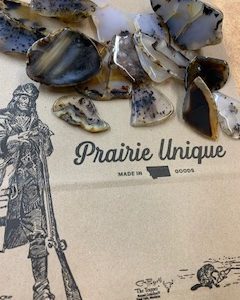It has always been a mystery to lay minds just how these peculiar little scenes and moss spots were caused by infinitely minute seams and fissures in the softer part of the rock being filled with metallic oxides when the world was young.
These oxides make four distinct colors that form various combinations when blended together, or only appear in single colors in one rock. The red color is oxide of iron, the green is oxide of copper, and the blue black is oxide of nickel.
This theory has been expanded by the use of microscopes and the tracing of little canals that once admitted water containing one or more of these metals in liquid form. The water dried out. The canals closed so the naked eye could not detect them, but the oxides remained staining the rock in wonderful designs. The fern-like and branch effects of trees, grass, and shrubbery come from the fact that these tiny canals branched out in various subdivisions forming smaller canals from a common center.
In addition to these canals, the rock became flawed through shrinkage while passing through a period of evaporation, which, according to scientists, has taken more than three million years to reduce the stone to seven parts of hardness. These canals and flaws have been perfectly healed by soft silicate formations of which the stone is a part. The evaporation has caused various oxides to take on such forms as are often seen on a window after a frosty night. Technically, MONTANA MOSS AGATE is known as “dentritic” agate, and the moss spots are called “dendrites” because of the tree-like designs. Local artists who use agate harvested from the nearby Yellowstone River produced the agate jewelry available for purchase from Prairie Unique, in Terry, Montana.


